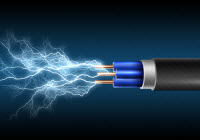Top 10 Electrical Safety Tips
Manage electrical hazards successfully with these 10 tips for keeping workers safe from shocks, burns, and electrocution.
 |
2. Get out in the field or plant and see what your workers are doing.
3. Develop checklists or other ways to track who is qualified to perform which tasks. Some businesses use job-task analyses to provide a blueprint of employees' activities.
4. Train your employees. To be qualified to perform any task, they must know the construction, operation, and hazards associated with the equipment they're using. Supervisors should be responsible for knowing what employees can do safely.
5. Develop safe work practices and procedures. Practices like energized electrical work permits, clearance procedures, and switching orders can help prevent accidents and can help document that the right steps were taken. This is especially important in case of an accident.
6. Perform periodic safety audits. When workers know they will be subject to random audits, they will try to maintain safe work procedures and practices.
7. Conduct job briefings any time the scope of the work changes significantly and when new or different hazards are present.
8. Be cautious about implementing safety awards programs, especially if they may discourage accident reporting.
9. Become familiar with NFPA 70E and the IEEE (Institute of Electrical and Electronics Engineers) Guide for Performing Arc Flash Hazard Calculations.
10. Document everything. "If you don't have it in writing, you never did it."
Show a good-faith effort; OSHA will notice.
hi
ReplyDelete